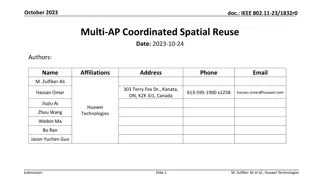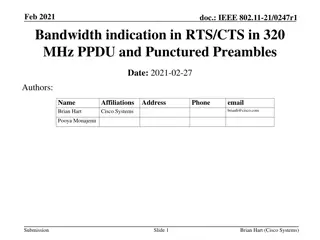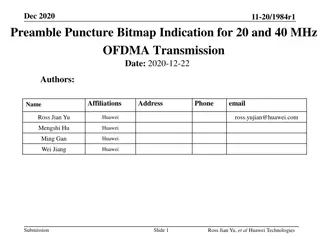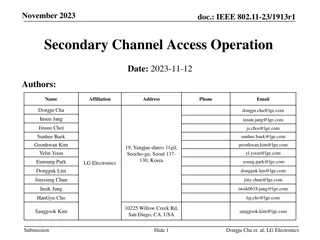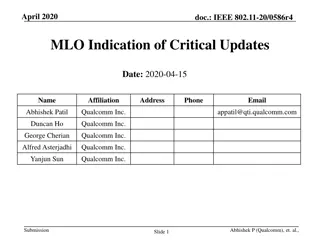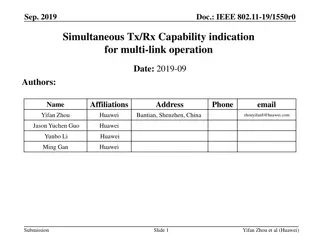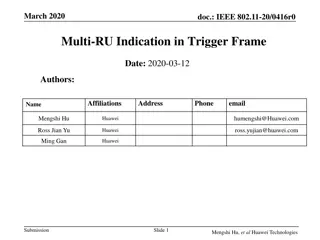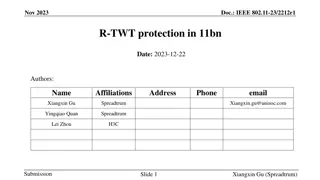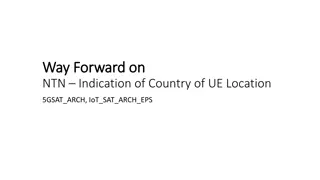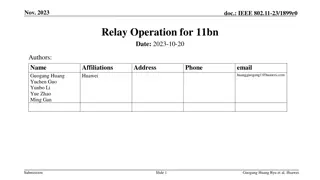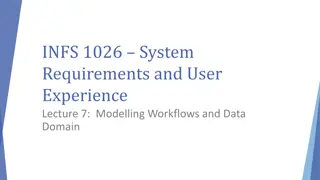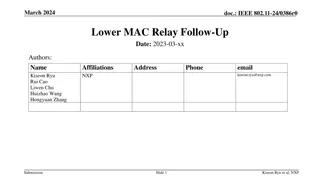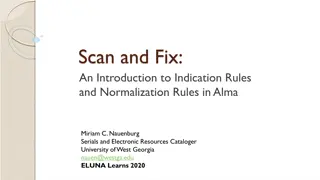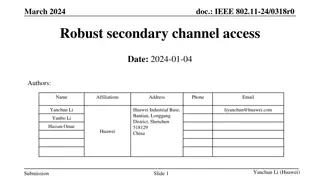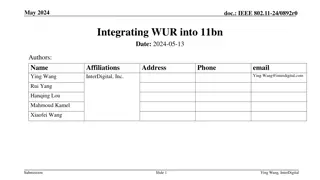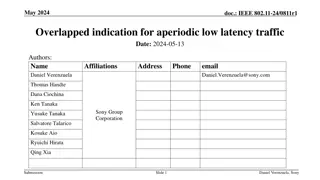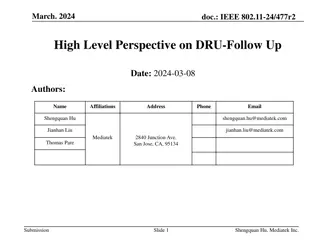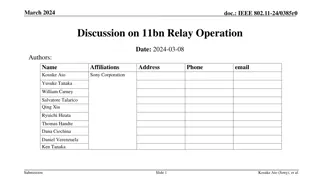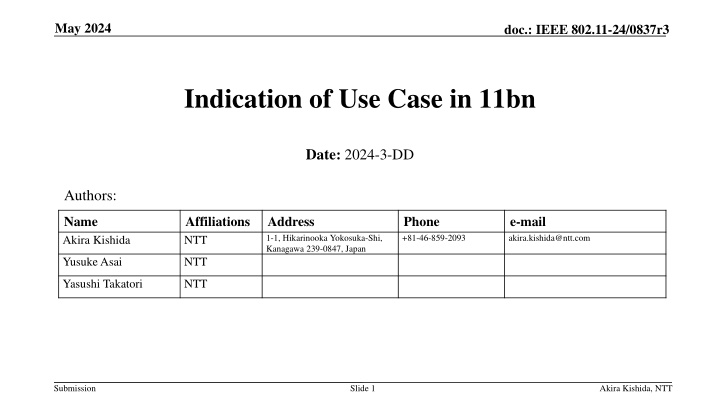
Indication of Use Case in 11bn: Enhancing IEEE 802.11-24/0837r3 Features
Explore the importance of indicating use cases in IEEE 802.11-24/0837r3 for effective utilization of 11bn features, such as multi-AP coordination, preemption, and connectivity enhancement. Different use cases like industrial automation and residential settings require specific network management and control mechanisms for optimal performance. Understanding use cases aids in selecting appropriate features, optimizing parameters, and efficient resource utilization in wireless networks.
Uploaded on | 1 Views
Download Presentation

Please find below an Image/Link to download the presentation.
The content on the website is provided AS IS for your information and personal use only. It may not be sold, licensed, or shared on other websites without obtaining consent from the author. If you encounter any issues during the download, it is possible that the publisher has removed the file from their server.
You are allowed to download the files provided on this website for personal or commercial use, subject to the condition that they are used lawfully. All files are the property of their respective owners.
The content on the website is provided AS IS for your information and personal use only. It may not be sold, licensed, or shared on other websites without obtaining consent from the author.
E N D
Presentation Transcript
May 2024 doc.: IEEE 802.11-24/0837r3 Indication of Use Case in 11bn Date: 2024-3-DD Authors: Name Akira Kishida Affiliations NTT Address 1-1, Hikarinooka Yokosuka-Shi, Kanagawa 239-0847, Japan Phone +81-46-859-2093 e-mail akira.kishida@ntt.com Yusuke Asai NTT Yasushi Takatori NTT Submission Slide 1 Akira Kishida, NTT
May 2024 doc.: IEEE 802.11-24/0837r3 Introduction In TGbn, various technologies to achieve KPIs in the PAR[1] and use cases in the CSD[2] are actively being discussed. E.g., multi-AP coordination (coordinated R-TWT and coordinated TDMA, etc) [3]-[12], preemption [13][14], TXOP sharing enhancement [15][16]. The effectiveness of those technologies strongly depends on the operating use case because the reliability requirement is different according to each use case[17][18]. Unlike previous amendments before 11be, 11bn (UHR) aims to achieve both throughput and reliability and the features that we should deploy depend on the environment and the use case. In this contribution, we discuss the indication of the use case to utilize 11bn features more effectively. Submission Slide 2 Akira Kishida, NTT
May 2024 doc.: IEEE 802.11-24/0837r3 Use case dependent 11bn features In specific use cases such as industrial automation [19], supporting traffic type for controlling AGV (Automated Ground Vehicle) or AMR (Autonomous Mobile Robot) should be required in addition to video transmission. In such use cases, network type will be managed network [20] or private network, and coordinated control (e.g., multi-AP coordination, coordinated TDMA) or collision-free access control (e.g., preemption, TXOP sharing enhancement) will be effective. On the other hand, connectivity enhancement (e.g., rate-vs-range, hitless handover) based on existing EDCA mechanisms will be important in use cases such as apartments, residents, or public places like stations and plazas. Complex coordination controls or collision-free access might cause fairness issues or connectivity degradation in such environments. Submission Slide 3 Akira Kishida, NTT
May 2024 doc.: IEEE 802.11-24/0837r3 Indication of use case in 11bn If the identification of the use case would be realized, appropriate 11bn features could be applied. Knowing the use cases of BSS and OBSS would help apply appropriate 11bn features to operate. If an AP can notify the use case and network type (e.g., managed or public) and an STA can indicate its STA type (e.g., AGV or AMR), the following advantages will be realized. Appropriate selection of 11bn features considering the environment. By knowing what type of use cases are operated, specific 11bn features can be determined whether to use. Efficient use of frequency resources by compartmentalization of managed and public networks. For instance, if the use case of the BSS is industrial automation and handles latency sensitive traffic, the other BSSs can avoid using the channels or links that the BSS utilizes by knowing its use case. Optimization of parameters according to the use case by defining the parameter set for each use case. This can reduce indication information size and avoid bloating management frames. Submission Slide 4 Akira Kishida, NTT
May 2024 doc.: IEEE 802.11-24/0837r3 Discussion on indication mechanism There are several possible mechanisms to indicate the use case. Option 1: reuse and extend the existing information elements (IEs). 11u defined an Interworking element, indicating access network type and detailed use cases (venue group). This IE is intended to interact with external networks and is used for Passpoint (Hotspot 2.0). However, this IE can be reused to inform the use case for 11bn features. 11ah defined Update EDCA Info field in EDCA Parameter Set element to override EDCA parameter set for specific STA type (i.e., sensor STA). There is room for consideration in extending this field to indicate STA types other than sensor STA. Option 2: define a new information element or signaling mechanism. The information element regarding the indication of the use case and the network type could be defined in TGbn. This IE is assumed to be included in the Beacon frame, Probe Request, and Probe Response frame. Including KPIs and requirements for those KPIs together in this IE would help to enhance reliability. Submission Slide 5 Akira Kishida, NTT
May 2024 doc.: IEEE 802.11-24/0837r3 Use and extend the existing IEs Interworking element (defined in 11u) Interworking element is utilized for active scanning for DMG STAs, generic advertisement service (GAS) protocol, WLAN interworking with external networks procedures, and access network query protocol (ANQP). It is used in Hotspot 2.0 as well. The Access Network Options field in the Interworking element can identify the type of access network, such as private or public networks. Submission Slide 6 Akira Kishida, NTT Akira Kishida, NTT
May 2024 doc.: IEEE 802.11-24/0837r3 Summary Unlike previous primary amendments, IEEE 802.11bn aims to improve reliability, and the reliability requirement is different according to each use case. The effectiveness of various technologies discussed in TGbn depends on use cases and environments. Indicating the use case leads to applying appropriate 11bn features. Possible mechanisms of the indication are discussed. Submission Slide 7 Akira Kishida, NTT
May 2024 doc.: IEEE 802.11-24/0837r3 SP Do you agree to extend the Access Network Options field in 11bn? Note: this intends to use reserved bits (6-13) in the Access Network Type in the Access Network Options field to indicate the UHR use cases (TBD). -Yes -No -Abstain Submission Slide 8 Akira Kishida, NTT
May 2024 doc.: IEEE 802.11-24/0837r3 Reference [1] [2] [3] [4] [5] [6] [7] [8] [9] [10] Liuming Lu, et al., Multi-AP Coordination for Low Latency Traffic Delivery, IEEE 802.11-23/1556r1 [11] Abhishek Patil, et al., Coordinated TDMA (C-TDMA) Follow-up, IEEE 802.11-23/1895r2 [12] Geonhwan Kim, et al., Coordinated TDMA Procedure, IEEE 802.11-23/1912r0 [13] Giovanni Chisci, et al., Preemption techniques to meet low-latency (LL) targets, IEEE 802.11-23/1886r1 [14] Kiseon Ryu, et al., TXOP Preemption Follow Up, IEEE 802.11-23/1174r0 [15] Sindhu Verma et al., Reverse TXOP sharing, IEEE 802.11-23/1874r0 [16] Dibakar Das et al., TXOP optimizations to support XR use-cases, IEEE 802.11-23/1387r0 [17] Inaki Val, et al., High Criticality Use Cases and Requirements, IEEE 802.11-23/1834r0 [18] Brian Hart, et al., Overview of Enterprise Policy and Goals, IEEE 802.11-23/2026r0 [19] Akira Kishida, et al., Considerations on UHR PAR and KPIs, IEEE 802.11-22/1919r4 [20] Inaki Val, et al., Managed Networks under highly congested scenarios, IEEE 802.11-23/1920r2 Laurent Cariou, et al., UHR proposed PAR, IEEE 802.11-23/0480r3 Laurent Cariou, et al., IEEE 802.11 UHR Proposed CSD, IEEE 802.11-23/0079r10 Arik Klein, et al., M-AP Coordinated Transmission framework, IEEE 802.11-23/1871r2 Yanchun Li, et al., Discussion on UHR enhanced channel access, IEEE 802.11-23/1973r0 Laurent Cariou, et al., R-TWT for Multi-AP, IEEE 802.11-23/0297r0 SunHee Baek, et al., R-TWT Coordination in Multi-BSS, IEEE 802.11-23/1916r1 Liuming Lu, et al., Coordinated R-TWT for Multi-AP scenarios - Follow up, IEEE 802.11-23/1952r1 Jeongki Kim, et al., Discussion on Enhanced R-TWT for UHR, IEEE 802.11-23/2084r0 Xiangxin Gu, et al., R-TWT protection in 11bn, IEEE 802.11-23/2212r0 Submission Slide 9 Akira Kishida, NTT
May 2024 doc.: IEEE 802.11-24/0837r3 APPENDIX Submission Slide 10 Akira Kishida, NTT
May 2024 doc.: IEEE 802.11-24/0837r3 Use and extend the existing IEs cont d The venue Info field in the Interworking element can indicate the venue group and the detailed use case. Reusing the Interworking element and these information fields in the element would help to specify the use case for indication. Submission Slide 11 Akira Kishida, NTT
May 2024 doc.: IEEE 802.11-24/0837r3 Reuse and extend the existing IEs cont d Update EDCA Info field in EDCA Parameter Set element. The S1G AP uses the STA Type field in Update EDCA Info field to specify STA types and validate information described in this field. Sensor STAs and non-sensor STAs are defined in S1G. STA Type field to 0 to indicate that the information provided by this element is valid for STAs (i.e., both sensor STAs and non-sensor STAs) 1 to indicate that the information is valid for sensor STAs 2 to indicate that the information provided by this element is valid for non-sensor STAs 3 to indicate a reserved value 11bn STA could use reserved value 3 and would create a subfield to describe more detailed use case type information. Submission Slide 12 Akira Kishida, NTT

